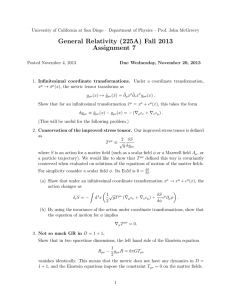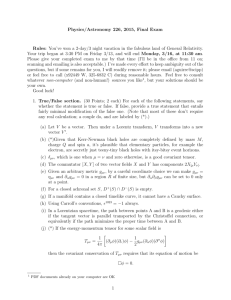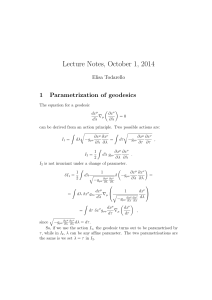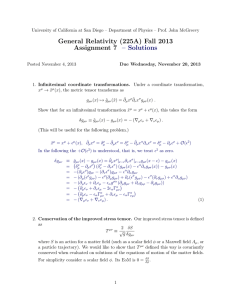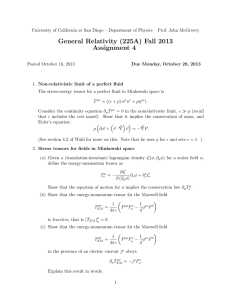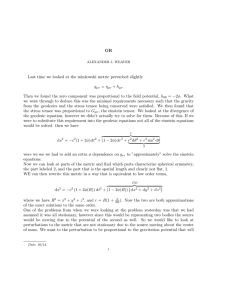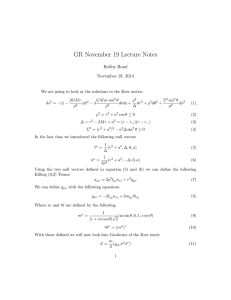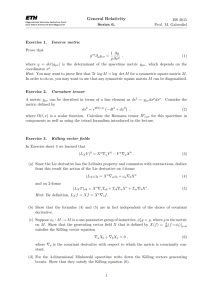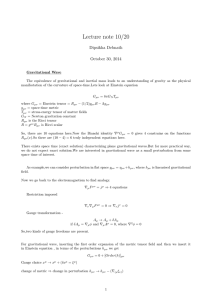Document 13650316
advertisement
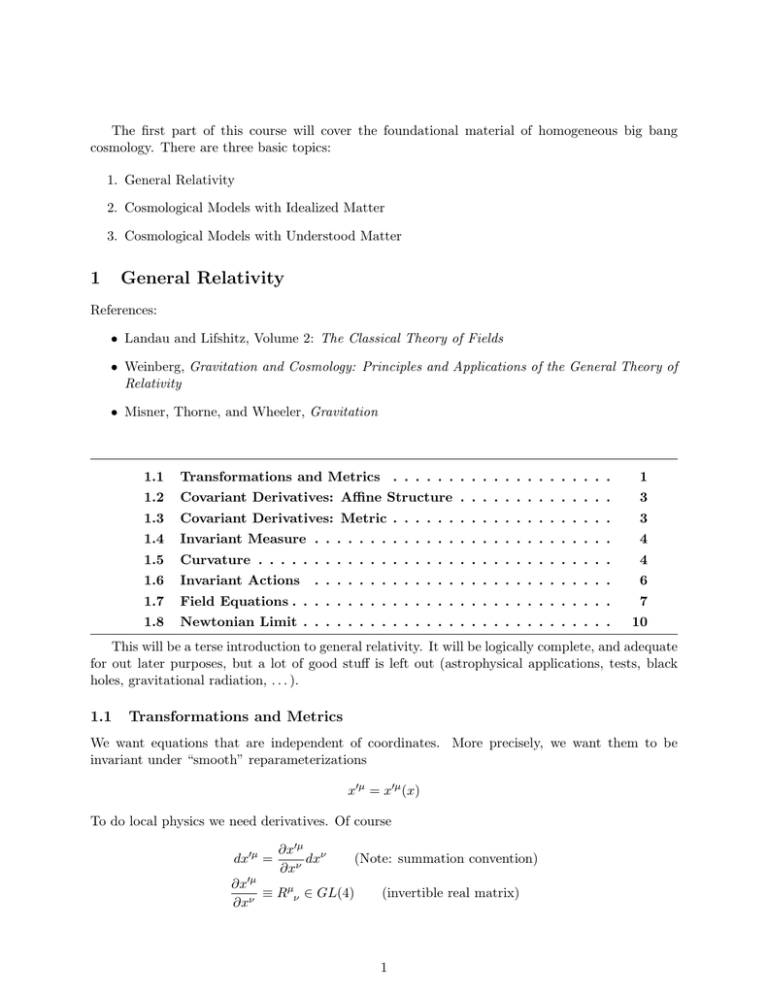
The first part of this course will cover the foundational material of homogeneous big bang cosmology. There are three basic topics: 1. General Relativity 2. Cosmological Models with Idealized Matter 3. Cosmological Models with Understood Matter 1 General Relativity References: • Landau and Lifshitz, Volume 2: The Classical Theory of Fields • Weinberg, Gravitation and Cosmology: Principles and Applications of the General Theory of Relativity • Misner, Thorne, and Wheeler, Gravitation 1.1 Transformations and Metrics . . . . . . . . . . . . . . . . . . . . 1 1.2 Covariant Derivatives: Affine Structure . . . . . . . . . . . . . . 3 1.3 Covariant Derivatives: Metric . . . . . . . . . . . . . . . . . . . . 3 1.4 Invariant Measure . . . . . . . . . . . . . . . . . . . . . . . . . . . 4 1.5 Curvature . . . . . . . . . . . . . . . . . . . . . . . . . . . . . . . . 4 1.6 Invariant Actions . . . . . . . . . . . . . . . . . . . . . . . . . . . 6 1.7 Field Equations . . . . . . . . . . . . . . . . . . . . . . . . . . . . . 7 1.8 Newtonian Limit . . . . . . . . . . . . . . . . . . . . . . . . . . . . 10 This will be a terse introduction to general relativity. It will be logically complete, and adequate for out later purposes, but a lot of good stuff is left out (astrophysical applications, tests, black holes, gravitational radiation, . . . ). 1.1 Transformations and Metrics We want equations that are independent of coordinates. More precisely, we want them to be invariant under “smooth” reparameterizations x�µ = x�µ (x) To do local physics we need derivatives. Of course dx�µ = ∂x�µ ν dx ∂xν (Note: summation convention) ∂x�µ ≡ Rµν ∈ GL(4) ∂xν (invertible real matrix) 1 We want to have special relativity in small empty regions, so we must introduce more structure. The right thing to do is to introduce a symmetric, non-singular (signature + – – –), tensor field gµν (x) so that we can define intervals ds2 = gµν dxµ dxν (“Pythagoras”) � For this to be invariant (gµν dx� µ dx� ν = gµν dxµ dxν ), we need � gµν (x� ) = (R−1 )αµ (R−1 )β ν gαβ (x) �µ �α ρ λ �α ∂x ∂x ∂x ∂x −1 ρ α Since Rµν = ∂x ∂xν , (R ) σ = ∂x�σ (chain rule: δβ = ∂x�β = ∂x�β ∂xλ ) We can write the transformation law for gµν in matrix form: G� = R−1 G(R−1 )T � From � 1 linear �algebra, we can insure G is diagonal with ±1 (or 0) entries. The signature, e.g. −1 , is determined. −1 −1 There are residual transformations that leave this form of gµν intact. They are the Lorentz transformations! Generalizing gµν , dxµ , we define tensors of more general kinds Tµ1 ...µm ν1 ...νn (x) by the transformation law T � µ1 ...µm ν1 ...νn (x� ) = (R−1 )α1 µ1 · · · (R−1 )αm µm Rν1 β1 · · · Rνn βn · Tα1 ...αm β1 ...βn (x) Example: Inverse metric g µν g µα gαν = δνµ Operations: • Muliplication by number • Tensor, of the same type can be added • Outer Product V ν1 W ν2µ ≡ T ν1 ν2µ • Contraction Tµ1 µ2 ...µm µ1 ν2 ...νn = T̃µ2 ...µm ν2 ...νm Example: gµν dxα dxβ = Tµν αβ a tensor Contraction: Tµν µν = ds2 “0” is a tensor (all components = 0). δνµ is a tensor. 2 1.2 Covariant Derivatives: Affine Structure • Scalar Field • Vector • Operator φ� (x� ) = φ(x) A�µ (x� ) = ∂ν� ≡ ∂xα ∂x�µ Aα (x) ∂ ∂x�ν = � (R−1 )αµ Aα � ∂xα ∂ ∂x�ν ∂xα Is there an invariant derivative? ∂ν� A�µ ∂xα = ∂x�ν ∂xα = �ν �∂x � β � ∂ ∂x Aβ ∂xα ∂x�µ ∂xβ ∂ 2 xβ ∂ A + A α β �µ �ν �µ β ∂x �� � �∂x ∂x �� � good bad (hard to use ­ not a tensor) Add correction term: �ν Aµ ≡ ∂ν Aµ − Γλνµ Aλ : ∂ 2 xσ �λ ��ν A�µ = S αν S βµ ∂α Aβ + �µ �ν Aσ − Γνµ S σλ Aσ ∂x ∂x � � ? = S αν S βµ ∂α Aβ − Γσαβ Aσ where S αν ≡ (R−1 )αν = This will work if ∂xα ∂x�ν . � ∂ 2 xσ ∂x� ν∂x�µ ∂x�λ ∂ 2 xσ = Rλσ S αν S βµ Γσαβ + ∂xσ ∂x� ν∂x�µ λ σ Γνµ S λ = S αν S βµ Γσαβ + � λ that is, Γνµ λ Note that the inhomogeneous part is symmetric in µ ↔ ν. So we can assume Γλαβ = Γβα consistently. (The antisymmetric “torsion” part is a tensor on its own!) Given Γ, we can take covariant derivatives as 1 �α Tµ1 ...µm ν1 ...νn = ∂α Tµ1 ...µm ν1 ...νn −Γλαµ1 Tλµ2 ...µm ν1 ...νn −. . .−Γλαµm Tµ1 ...λ ν1 ...νn +Γναλ Tµ1 µ2 ...µm λν2 ...νn This gives a tensor. We use the Leibniz rule in products. 1.3 Covariant Derivatives: Metric Big result: given a metric, there is a unique preferred connection Γ Demand �λ gµν = 0 (and symmetry) α α 0 = ∂λ gµν − Γλµ� gαν − Γλν� gαµ 0 = ∂µ gνλ � �� � � α − Γαλµ gαν �− �� Γµν gαλ � � �� � � α α 0 = ∂ν gλµ − Γλν gαµ − Γµν gαλ 3 Subtract the first line from the sum of the second and third: 2Γαµν gαλ = ∂µ gλν + ∂ν gλµ − ∂λ gµν � � g λβ 1 × : Γβµν = g λβ ∂µ gλν + ∂ν gλµ − ∂λ gµν 2 2 Conversely, this works! Extra term in Γ� : � � � � 1 λβ � � ∂xσ��� ∂xσ � g ∂µ�� gσν + ∂µ �ν gλσ �� 2 ∂x ∂x�λ � � � � � � � � σ σ σ � �� ∂xσ��� � ∂x � ∂x � ∂x �� �� � � + ∂�ν� �� g + ∂ g − ∂ g − ∂ g σµ ν σν σµ λσ λ� �µ λ� �ν � ∂x�λ �� �� ∂x�µ ∂x ∂x The boxed terms give the desired inhomogeneous terms; the others cancel. 1.4 Invariant Measure � ∂x�µ det ∂xν � �� � � 4 � d x = Jacobian; � gµν = ∂xα d4 x = det R ∂xβ g ∂x�µ ∂x�ν αβ G� = R−1 G(R− 1)T 1 � det gµν = det gµν (det R)2 Write g ≡ det(gµν ); then g � d4 x� = � √ 4 gd x is an invariant measure. 1.5 Curvature In order to make the gµν into dynamical variables, we want them to appear with derivatives in the Lagrangian. Can we form tensors such that this occurs? Trick: (�µ �ν − �ν �µ ) Aβ ≡ − Rαβµν · Aα ���� � �� � involves g no derivatives This Rαβµν automatically transforms as a proper tensor; the “hard” part is to show that the derivatives on Aα all cancel so we get this form. �µ Aβ = ∂µ Aβ − Γλνβ Aλ �µ (�ν Aβ ) = ∂µ (�ν Aβ ) − �σ� Γσµν A� �� β � � �� � −Γσµβ �ν Aσ symm etric ⇒ drop it ρ σ σ σ =� ∂µ� ∂ν� A� β − ∂µ (Γνλ Aσ ) − Γµν ∂ν Aσ + Γµβ Γνρ Aσ σ − ∂µ Γνλ Aσ − Γσνλ ∂µ Aσ − Γσµλ ∂ν Aσ + Γρµβ Γσνρ Aσ α − ∂ Γα + Γα Γρ − Γα Γρ so Rαβµν = ∂µ Γνβ ν µβ µρ νβ νρ µβ 4 Symmetry properties of Rαβγδ ∂g We can go to a frame where ∂xµν λ = 0 (at point of interest). These are “geodesic coordinates”. There we know that Γαβγ = 0 (but not its derivatives!) Then � �� 1 � � ασ � Rαβµν = ∂µ g ∂ν gσβ − ∂β gνσ − ∂σ gβν − (µ ↔ ν) 2 � � 1 = g ασ ∂µ ∂β gνβ − ∂µ ∂σ gβν − ∂ν ∂β gµσ − ∂ν ∂σ gβµ 2 = g ασ Rσβγδ � � with Rαβγδ = 12 ∂α ∂δ gβγ + ∂β ∂γ gαδ − ∂α ∂γ gβδ − ∂β ∂δ gαγ ⇒ Rαβγδ = −Rβαγδ Rαβγδ = −Rαβδγ Rαβγδ = Rγδαβ Rαβγδ + Rαγδβ + Rαδβγ = 0 (e.g. Look at the coefficient of ∂α ∂δ gβγ : +1 in Rαβγδ −1 in Rαγδβ 0 in Rαδβγ ) Since these are tensor identities, they hold in any frame! Also notable is the Bianchi identity; �α Rµνβγ + �β Rµνγα + �γ Rµναβ = 0 It follows from: [�α , [�β , �γ ]] + [�β , [�γ , �α ]] + [�γ , [�α , �β ]] = � α � β � γ − � α � γ � β − � β �γ � α + � γ � β � α + �β �γ �α − �β �α �γ − �γ �α �β + �α �γ �β + � γ � α � β − � γ � β � α − � α � β � γ + � β �α �γ = 0 e.g.: (1) (2) � � �α [�β , �γ ]Aµ = −�α Rν µβγ Aν = −�α Rν µβγ Aν − Rν µβγ �α Aν −[�β , �γ ]�α Aµ = Rν αβγ �ν Aµ + Rν µβγ �α Aν (3) (4) (2) cancels against (4), (3) will go away by the symmetry of Rν αβγ + Rν βγα + Rν γαβ = 0, so (1) generates the Bianchi identity. This identity is the gravity analogue of ∂α Fβγ + ∂β Fγα + ∂γ Fαβ = 0 in electromagnetism, or � · B = 0, � × E = − ∂B ∂t (existence of vector potential). 5 1.6 Invariant Actions �√ 4 Since we have an invariant measure gd x (L ), we get invariant field theories by putting invariant expressions inside (L ). Given a special-relativistic invariant theory, we just need to change √ d4 x → gd4 x ηµν → gµν ∂µ → �µ to make a general-relativistic invariant theory. This is the “minimal coupling” procedure. Examples: 1. Scalar field: L = 12 g µν ∂µ φ ∂ν φ − V (φ) 2. Transverse vector field Fµν = �µ Aν − �ν Aµ = ∂µ Aν − Γσµν Aσ − ∂ν Aµ + Γσνµ Aσ = ∂µ Aν − ∂ν Aµ (no need for Γ, or ∂g) 1 L = − g αγ g βδ Fαβ Fγδ 4 supports gauge symmetry Aµ → Aµ + ∂µ χ 3. Longitudinal vector field (instructive) �µ Aµ = ∂µ Aµ + Γµµα Aα � 1 �� � Γµµα = g µσ ∂α gσµ + � ∂µ� gασ −� ∂σ� gµα �� 2 1 = g µσ ∂α gσµ 2 1 √ = √ ∂α g g [To prove ∂α g = gg µσ ∂α gµσ , use expansion by minors and expansion for inverse matrix. Check on diagonal matrices!] �√ µ � � � √ √ So �µ Aµ = √1g ∂µ gA . Thus d4 x g �µ Aµ = d4 x ∂µ ( gaµ ) is semi-trivial: it is a boundary term. � d4 x�µ Aµ �ν Aν gives dynamics. This supports a gauge transformation √ µ √ gA → gAµ + �µνρσ ∂ν Λρσ Λρσ = −Λσρ 4. Gravity itself R = g βγ Rαβαγ and 1 are invariant. The latter is non-trivial, due to the measure factor � 4 √ d x g “Cosmological term” 5. Spinors! These are foundational, but relegated to the Appendix. 6 1.7 Field Equations 1. Scalar field Λ � S= � � �� �� 1 √ d4 x g g µν ∂µ φ∂ν φ − V (φ) 2 δΛ δΛ = δ∂µ φ δφ √ µν √ ∂µ ( gg ∂ν φ) = − gV � (φ) ∂µ or �µ (g µν ∂ν φ) = −V � (φ) 2. Transverse vector field � � 1 √ 4 √ αγ βδ S=− d x gg g (∂α Aβ − ∂β Aα ) (∂γ Aδ − ∂δ Aγ ) − d4 x gj µ Aµ 4 � �� � coupling to current √ �√ � δ gL ∂µ = −∂µ gg µγ g νδ (∂γ Aδ − ∂δ Aγ ) δ∂µ Aν √ √ · = −∂µ ( gF µν ) = − g �µ F µν exercise! √ δ gL √ = − gj ν δ∂µ Aν Equation of motion: �µ F µν = j ν �√ � √ or ∂µ gg µγ g νδ Fγδ = gj ν As a consistency condition we have: ∂ν �√ � √ gj ν = 0 ⇒ g �ν j ν 3. Longitudinal vector field � � 1 √ 1 √ √ √ g √ ∂µ ( gAµ ) √ ∂ν ( gAν ) g �µ Aµ �ν Aν = g g � 1 ≡ √ ∂µ pµ ∂ν pν g � � δL 1 µ σ ∂µ = 2∂µ √ δν ∂σ p δ∂µ pν g � � 1 = 2∂ν √ ∂σ pσ g If there is no source, then we have that √1g ∂σ pσ = λ, which is constant. �√ �√ g �µ Aµ �ν Aν → λ2 So g gives a “dynamical” cosmological term 4. Field equation for gravity 7 √ a. The hard part of finding the field equation for gravity is varying gg αβ Rαβ . However, √ we can use the trick that gg αβ δRαβ is a total derivative. To painlessly, we can adopt a system of locally geodesic coordinates � prove this relatively � ⇒ ∂α gβγ = 0 . Then � � µ g αβ δRαβ = g αβ ∂µ δΓαβ − ∂α δΓµβµ � � = ∂µ g αβ δΓµαβ − g µβ δΓαβα ≡ ∂µ ω µ Note that δΓ has no inhomogeneous terms in its transformation law - it is a tensor! So √ g αβ δRαβ = ∂µ ω µ → �µ ω µ is now valid in any coordinate system. So gg αβ δRαβ = � � √ √ g�µ ω µ = ∂µ gω µ is a boundary term; it does not contribute to the Euler-Lagrange equations. �√ gR we get Thus with S = κ ⎛ � δS = κ ⎞ R � �� � √ ⎜ √ αβ ⎟ αβ ⎝δ g g Rαβ + gδg Rαβ ⎠ 1√ √ ggαβ δg αβ R + gRαβ δg αβ 2 � � � 1 √ =κ g Rαβ − gαβ R δg αβ 2 � − =κ b. We have for the cosmological term √ δS = −Λ δ g � � � 1 √ =Λ g g δg αβ 2 αβ � c. Matter � S= √ gΛ � � � √ √ δ gΛ δ gΛ δS = − ∂µ δg αβ δg αβ δ∂µ g αβ We define the energy-momentum tensor by √ √ √ δ gΛ δ gΛ g − ∂µ = T αβ αβ 2 αβ δg δ∂µ g We will now see that this makes sense with both examples and conservation laws. i. Examples: 8 • Scalar field: 1 1 Λ = g αβ ∂α φ∂β φ − m2 φ2 2 2 √ δ gΛ 1√ =− ggαβ Λ 2 δg αβ � � �� √ g 1 √ 1 µν 1 2 2 1√ Tαβ = − ggαβ g ∂µ φ∂ν φ − m φ + g∂α φ∂β φ 2 2 2 2 2 1 1 Tαβ = ∂α φ∂β φ + gαβ m2 φ2 − gαβ g µν ∂µ φ∂ν φ 2 2 In flat space we have: � 1 1� T00 = ∂0 φ∂0 φ + m2 φ2 − ∂0 φ∂0 φ − (�φ)2 2 2 1 2 1 1 � = φ̇ + (�φ)2 + m2 φ2 = W SB 2 2 2 • Maxwell field: (now we use δ �√ gg αγg βδ Fαβ Fγδ � Tµν g µν Tµν δ δg µν ) 1 √ √ = − gµν gg αγ g βδ Fαβ Fγδ + 2 gg βδ Fµβ Fµδ 2� � �√ � 2 1 − =√ δ gg αγ g βδ Fαβ Fγδ g 4 1 = −Fµβ Fνδ g βδ + gµν g αγ g βδ Fαβ Fγδ ⇒ 4 = 0 (�) In flat space we have: � 1 � 2 · 2 B − E2 4 � � 1� 2 = E + B2 2 T00 = E 2 + As an exercise, check the Poynting vector and stresses for the Maxwell field. ii. Conservation laws Preliminary: We expect the conservation of energy-momentum to be tied up with invariance under translations. So: let us translate! x�µ − xµ = δxµ = �µ , � small, vanishing at ∞ ∂x�µ ∂x�ν αβ g (x) ∂xα ∂xβ ≈ g µν (x) + ∂α �µ g αν + ∂β �ν g µβ g µν (x� ) = � g µν (x� ) ≈ g µν + ∂α g µν �α � Thus δg µν = g µν (x) = ∂α �µ g αν + ∂α �ν g µα − ∂α g µν �α ↑ not x� 9 Now notice that δg µν = g αµ �α �ν + g αν �α �µ (Killing equations) Γναρ � �� � � � ρ αµ ν αµ 1 νβ = g ∂α � + g · g ∂α gβρ + ∂ρ gαβ − ∂β gαρ � 2 � � 1 + g αν ∂α �µ + g αν · g µβ ∂α gβρ + ∂ρ gαβ − ∂β gαρ �ρ 2 = g αµ ∂α �ν + g αν ∂α �µ + g αµ g ρν ∂ρ gαβ �ρ = g αµ ∂α �ν + g αν ∂α �µ − ∂ρ g αβ �ρ where the last step follows from differentiating: gαµ g µβ = δαβ ; so ∂λ gαµ g µβ + gαµ ∂λ g µβ = 0. Multiplying by g ρα , we get ∂λ gαµ g µβ g ρα = −∂λ g ρβ . We can also write this as δg µν = �ν;µ + �µ;ν . Now we have, from the invariance of the action and symmetry of Tµν in its definition � √ 0= g Tµν �µ;ν But also � ∂ν � √ 0= �√ g Tµν �µ � � � g �µ Tµν �µ � � √ √ ν = g � Tµν + gTµν �µ;ν � �� � = 0 Since this holds for an arbitrary �µ , we conclude that �ν Tµν = 0. 1.8 Newtonian Limit We should be able to identify Newtonian gravity (and fix the coupling constant) by looking at the situation with nearly flat space and only T00 = ρ significant. (For now, of course, we ignore the cosmological term.) The stationary action condition gives � � 1 1 κ Rαβ − gαβ R = Tαβ or 2 2 1 2κRαβ = Tαβ − T gαβ 2 Focus on R00 : 2κR00 = (g00 ≈ c2 � gij ) ρ 2 in R···· terms with ΓΓ pieces higher order. Also terms with R00 ≈ ∂γ Γγ00 − ∂0 Γγ0γ ≈ 1 − → �2 g00 2 10 ∂ ∂x0 ∼ 1 ∂ c ∂xi are small. Thus in and finally 2κ�2 g00 = ρ To interpret this, wrte g00 = 1 + � (g 00 = 1 − �). The action density of matter is perturbed by √ δ( gΛ) ρ ≈− � 00 δg 2 This looks like the Newtonian coupling if � = 2φ. The equation 2κ�2 g00 = ρ ⇒ 4κ�2 φ = ρ This fixes κ = 1 16πGN . � GN M GN M Gauss φ=− ; �φ = r̂ −−−→ r r2 � dV �2 φ = 4πGN M ���� � M = 4κ Note on the appendices and scholia: These are not necessarily self-contained, specifically, they refer to facts about quantum field theory and the standard model that are not assumed elsewhere in the course. Don’t worry if not everything is clear (or even meaningful) to you at this stage. Ask me if you’re curious! Central material 1. The notion of local Lorentz invariance, vierbeins, and R recipe (Appendices 1-2). 2. The idea that we are building a model of the world and are free to try anything (Scholium 4). Appendix 1: Spinors and Local Lorentz Invariance Spinor fields play a very important role in fundamental physics, so we must learn how to treat them in general relativity. The essential thing is to define γ a matrices. They transform under Lorentz transformations (that are in SO(3, 1) not GL(4)). Indeed the defining relation γ a γ b + γ b γ a = 2η ab refers to the flat-space Minkowski metric and the transformation law a γ � = S −1 (Λ)γ a S(Λ) = Λab γ b requires an S that does not exist in general. (Λ ∈ GL(4).) So we postulate local Lorentz invariance under transformations of this form with Λ(x) a function of x, Λ(x) ∈ SO(3, 1). To connect this structure to the metric we introduce a vierbein eaµ (x) such that ηab eaµ (x)ebν (x) = gµν (x) (“square root” of the metric) g µν eaµ (x)ebν (x) = η ab (“moving frame”) Now, for example, we can form the Dirac equation (γ a eµa Dµ + m) ψ = 0 11 But Dµ needs discussion. We want invariance under local Lorentz transformations. This requires (exercise!) Dµ S(Λ(x)) = S(Λ(x))Dµ a typical gauge invariance. We solve this problem “as usual” by introducing a gauge potential ωµab (x) ∈ so(3, 1) where so(3, 1) is the Lie algebra corresponding to SO(3, 1), and thus ωµab (x) = −ωµba (x), and (in matrix notation) ωµ� (x) = Λ−1 ωµ (x)Λ − Λ−1 ∂µ Λ and writing Dµ = � µ + ω µ · τ where the τ matrices provide the appropriate representation of the symmetry, e.g. σ ab = for spin 12 or the identity for spin 1. To avoid introducing additional structure (c.f. Scholium 4) we demand Dµ eaν = ∂µ eaν − Γαµν eαa + ωµ ab eνb = 0 i 4 � a b� γ ,γ (1) leading to a unique determination α ωµ ac = −eνc ∂µ eaν + ecν eαa Γµν Appendix 2: Moving Frames Method and Recipe The discussion of Appendix 1 is not as profound as it should be: ωµab should be “more primitive” than Γ. This is worth pursuing, since it leads to a beautiful analogy and useful formulae. We can eliminate Γ from the defining relation (1) for ω by antisymmetrizing in µ ↔ ν. Thus ∂µ eaν − ∂ν eaµ = ωµac ecν − ωνac ecµ To solve for ω we go through a slight rigamarole, reminiscent of what we did to get Γ from �g = 0 � � �� ωνac +eaρ ∂µ eaν − ∂ν eaµ = ωµac eaρ ecν − � aρ ecµ � e� �� ��� ��� �� � � � �� ωνac ωρac −eaµ ∂ν eaρ − ∂ρ eν = −� �e� aµ ecρ + � aµ ecν � e� �� � � �� ��� � a � ��� ac ac � a ωρ�e� +eaν ∂ρ eµ − ∂µ eρ = � aν ecµ − ωµ eaν ecρ � � a eaρ ∂µ eaν − eaρ ∂ν eaµ − eaµ ∂ν eaρ + eaµ ∂ρ eaν + eaν ∂ρ eaµ − eaν ∂µ eaρ = 2ωµac eaρ ecν using ωµac = −ωµca . Multiplying both sides by eeρ ef ν , we get A 2ωµef B C C B A � �� � � �� � � �� � � �� � � �� � � �� � = ef ν ∂µ eeν − ef ν ∂ν eaµ − eaµ eρe eνf ∂ν eaρ + eaµ eeρ ef ν ∂ρ eaν + eρe ∂ρ efµ − eρe ∂µ efρ or ωµef = � ef ν � ∂µ eeν − ∂ν eeµ + eaµ eeρ ∂ρ eaν − (e ↔ f ) 2 12 Now we can construct a curvature by differentiating (say) a space-time scalar, which is a local Lorentz vector field (Dµ Dν − Dν Dµ )φa = Rµν ab φb This leads to Rµν ab = ∂µ ων ab − ∂ν ωµ ab + ωµ ac ων cb − ων ac ωµ cb Now you will be delighted (but not too surprised) to learn that this “gauge” curvature is intimately related to the Riemann curvature we had before; indeed Rµναβ = Rµν ab eaα ebβ This actually gives the most powerful recipe for computing R. The technique of introducing frames eaµ (x) to make the geometry “locally flat” was developed by E. Cartan and is called the moving frame method. It is usually presented in very obscure ways. Scholium 1: Structure and Redundancy Allowing a very general framework and demanding symmetry is an alternative to finding a canon­ ical form that “solves” the symmetry. Thus we consider general coordinate transformations, but postulate a metric to avoid “solving” for local Lorentz frames and then pasting them together. Vierbeins or moving frames make this much explicit. Fixing down to a specific frame is gauge fixing in the usual sense. Scholium 2: Why General Relativity? Ordinary spin-1 gauge fields are in danger of producing wrong-metric particles or “ghosts”. This is because covariant quantization conditions (commutation relatives (?) ) for the different polar­ izations: [a†µ , aν ] = −gµν if normal for the space-like pieces are abnormal for the time-like and vice versa. Gauge symmetry allows me to show the wrong-metric excitations don’t couple (e.g. one can choose A0 = 0 gauge). Similarly, general convariance/local Lorentz symmetry are required for consistent quantum theories of spin 2. Scholium 3: General Relatvitiy vs. Standard Model In the Standard Model symmetry and weak cutoff dependence (renormalizability) greatly restrict the possible couplings. One requries a linear manifold of fields (i.e. φ1 (x) + φ2 (x) is allowed if φ1 (x), φ2 (x) are). In General Relativity there is still symmetry, and minimal coupling leads to weak cutoff de­ 1 + g 2 may not pendence below the Planck scale. However, the fields manifold is not linear (gµν µν be invertible, hence not allowed) and there is a dimensional fundamental coupling. It looks like an effective theory thus, with spontaneous symmetry breaking, i.e. eaµ = �?�, like the σ−model. 13 Scholium 4: Gauge and Dilaton Extensions The standard assumption of Riemannian geometry is �α g µν = 0. However, we might want to relax this to incorporation additional symmetry. Some important physical ideas have arisen (or have natural interpretations) along this line. Weyl wanted to unify electromagnetism with gravity. He postulated �α gµν = sα gµν and the symmetry � gµν (x) = λ(x)gµν (x) s�α (x) = sα + ∂α λ This was the historical origin of gauge invariance! He wanted to identify sα with the electromagnetic potential Aα . That has problems, but the ideas are profound. � Symmetry of the type gµν (x) = λ(x)gµν (x) arises in modern conformal field theory and string theory. It is called “Weyl symmetry”. Given the importance of massless particles, and the idea that massive fundamental particles can acquire mass by spontaneous symmetry breaking, this idea of a scale symmetry retains considerable appeal. A closely related variant is �α gµν = ∂α φ gµν � gµν = λgµν φ� = φ + λ φ-fields of this sort are called “dilatons”. 14
